In his first address after being sworn in on Monday, President Donald Trump repeated several false and misleading statements that he made during his campaign. They included claims about immigration, the economy, electric vehicles, and the Panama Canal. In remarks later at the Capitol’s Emancipation Hall, he issued several other false claims, including one that distorts pardons made by President Joe Biden as he left office. Here’s a look at the facts.
Biden did not pardon 33 murderers
CLAIM: Trump, at Emancipation Hall, said Biden pardoned “what is it, 33 murderers, absolute murderers, the worst murderers. You know, when you get the death sentence in the United States, you have to be bad.”
THE FACTS: Biden announced on Dec. 23 that he was commuting the sentences of 37 of the 40 people on federal death row, converting their punishments to life imprisonment. A commutation does not exonerate the person.
In making the announcement, Biden said: “These commutations are consistent with the moratorium my Administration has imposed on federal executions, in cases other than terrorism and hate-motivated mass murder.”
The move spared the lives of people convicted in killings, including the slayings of police and military officers, people on federal land, and those involved in deadly bank robberies or drug deals, as well as the killings of guards or prisoners in federal facilities.
The three federal inmates that now face execution are Dylann Roof, who carried out the 2015 racist slayings of nine Black members of Mother Emanuel AME Church in Charleston, South Carolina; 2013 Boston Marathon bomber Dzhokhar Tsarnaev; and Robert Bowers, who fatally shot 11 congregants at Pittsburgh’s Tree of life Synagogue in 2018, the deadliest antisemitic attack in U.S history.
Trump resurfaces false claim about the 2020 election
CLAIM: “2020, by the way, that election was totally rigged.” — remarks at Emancipation Hall.
THE FACTS: The election was not rigged. Authorities who have reviewed the election — including Trump’s own attorney general — have concluded the election was fair.
Biden won the Electoral College with 306 votes to Trump’s 232, and the popular vote by more than 7 million ballots. Recounts in key states affirmed Biden’s victory, and lawsuits challenging the results were unsuccessful.
Nancy Pelosi did not reject National Guard troops on Jan. 6
CLAIM: Calling the Select Committee to Investigate the Jan. 6th Attack on the United States Capitol the “Unselect Committee of political thugs,” Trump alleged that then-House Speaker Nancy Pelosi “turned down the offer of 10,000 soldiers” on Jan. 6, 2021, and that she was “in charge of security at the Capitol.” — remarks at Emancipation Hall.
THE FACTS: Trump has frequently claimed Pelosi rejected his offer to send National Guard troops to the Capitol on Jan. 6. While he was involved in discussions in the days before Jan. 6 about whether the National Guard would be called ahead of the joint session, he issued no such order or formal request before or during the rioting, and the guard’s arrival was delayed for hours as Pentagon officials deliberated over how to proceed.
In a 2022 interview with the Democratic-led House committee that investigated the attack, Christopher Miller, the acting defense secretary at that time, confirmed that there was no order from the president.
Pelosi did not direct the National Guard. However, as the Capitol came under attack, she and then-Senate Majority Leader Mitch McConnell called for military assistance, including from the National Guard.
The Capitol Police Board makes the decision on whether to call National Guard troops to the Capitol. It is made up of the House Sergeant at Arms, the Senate Sergeant at Arms, and the Architect of the Capitol. The board decided not to call the guard ahead of the insurrection but did eventually request assistance after the rioting had already begun, and the troops arrived several hours later.
The House Sergeant at Arms reported to Pelosi and the Senate Sergeant at Arms reported to McConnell. There is no evidence that either Pelosi or McConnell directed the security officials not to call the guard beforehand. Drew Hammill, a then-spokesperson for Pelosi, said after the insurrection that Pelosi was never informed of such a request.
Trump repeats unfounded claim about immigrants
CLAIM: Trump, a Republican, said in his inaugural address that the U.S. government “fails to protect our magnificent, law-abiding American citizens but provides sanctuary and protection for dangerous criminals, many from prisons and mental institutions that have illegally entered our country from all over the world.”
THE FACTS: There is no evidence other countries are sending their criminals or the mentally ill across the border.
Trump frequently brought up this claim during his most recent campaign.
Inflation did not reach record highs under Biden
CLAIM: “I will direct all members of my Cabinet to marshal the vast powers at their disposal to defeat what was record inflation and rapidly bring down costs and prices.” — inaugural address.
THE FACTS: Inflation peaked at 9.1% in June 2022 after rising steadily in the first 17 months of Democrat Joe Biden’s presidency from a low of 0.1% in May 2020. The most recent data shows that as of December it had fallen to 2.9%.
Other historical periods have seen higher inflation, such as a more than 14% rate in 1980, according to the Federal Reserve.
The average price of basic consumer goods has seen major spikes in recent years. For example, a dozen large eggs went from a low of $1.33 in August 2020 to $4.82 in January 2023. They decreased in price to $2.07 in September 2023 but are currently on the rise again, at $4.15 as of December, partly attributable to a lingering outbreak of bird flu coinciding with high demand during the holiday baking season.
A gallon of whole milk rose to a high of $4.22 in November 2022, up from $2.25 at the start of Biden’s term. As of December, it was at $4.10.
Gasoline fell as low as $1.77 a gallon under Trump. But that price dip happened during coronavirus pandemic lockdowns when few people were driving. The low prices were due to a global health crisis, not Trump’s policies.
Under Biden, gasoline rose to a high of $5.06 in June 2022. It has since been on a downward trend, at $3.15 as of December.
The promise of an External Revenue Service to collect tariffs
CLAIM: Promising to establish an External Revenue Service to collect “all tariffs, duties, and revenues,” Trump said in his inaugural address, “It will be massive amounts of money pouring into our Treasury, coming from foreign sources.”
THE FACTS: Nearly all economists point out that American consumers will pay at least part, if not most, of the cost of the tariffs. Some exporters overseas may accept lower profits to offset some of the cost of the duties, and the dollar will likely rise in value compared with the currencies of the countries facing tariffs, which could also offset some of the impact.
But the tariffs won’t have the desired impact of spurring more production in the U.S. unless they make foreign-made products more expensive for U.S. consumers.
In addition, many of Trump’s supporters, and even some of his appointees, argue that he intends to use tariffs primarily as a bargaining tool to extract concessions from other countries. Yet if an External Revenue Service is established, it certainly suggests Trump is expecting to impose and collect many duties.
Calls for revocation of EV mandate that doesn’t exist
CLAIM: “We will revoke the electric vehicle mandate, saving the auto industry and keeping my sacred pledge to our great American autoworkers.” — inaugural address.
THE FACTS: It’s misleading to claim that such a mandate exists. In April 2023, the Environmental Protection Agency announced strict limits on greenhouse gas emissions from passenger vehicles. The agency says these limits could be met if 67% of new-vehicle sales are electric by 2032.
And yet, the new rule would not require automakers to boost electric vehicle sales directly. It sets emissions limits and allows automakers to choose how to meet them.
In 2019, Kamala Harris co-sponsored a bill as a U.S. senator called the Zero-Emission Vehicles Act that would have required 100% of new passenger vehicles sold to be zero-emission by 2040. The bill, which stalled in committee, did not ban ownership of vehicles that produce emissions.
China does not operate the Panama Canal
CLAIM: Discussing his desire for the U.S. to take back the Panama Canal: “American ships are being severely overcharged and not treated fairly in any way, shape or form, and that includes the United States Navy. And, above all, China is operating the Panama Canal.” — inaugural address.
THE FACTS: Officials in Panama have denied Trump’s claims that China is operating the canal and that the U.S. is being overcharged. Ricaurte Vásquez, administrator of the canal, said in an interview with The Associated Press that “there’s no discrimination in the fees.”
“The price rules are uniform for absolutely all those who transit the canal and clearly defined,” he said.
He also said China was not operating the canal. He noted that Chinese companies operating in the ports on either end of the canal were part of a Hong Kong consortium that won a bidding process in 1997. He added that U.S. and Taiwanese companies are operating other ports along the canal as well.
Vásquez stressed that the canal couldn’t give special treatment to U.S.-flagged ships because of a neutrality treaty. He said requests for exceptions are routinely rejected because the process is clear and there mustn’t be arbitrary variations. The only exception in the neutrality treaty is for American warships, which receive expedited passage.
Trump, complaining about rising charges for ships transiting the canal, has refused to rule out the use of military force to seize control of the canal.
The United States built the canal in the early 1900s as it looked for ways to facilitate the transit of commercial and military vessels between its coasts. Washington relinquished control of the waterway to Panama on Dec. 31, 1999, under a treaty signed in 1977 by President Jimmy Carter, a Democrat.
President Donald Trump‘s second term began with efforts to deliver on key campaign promises, including his vows to crack down on immigration and restore “ energy dominance.”
In his first Oval Office appearance in his second term, he issued sweeping pardons for people charged in the Jan. 6 riot at the Capitol and declared a “national emergency” at the U.S.-Mexico border.
Some of these early moves are likely to be popular with the public. Most Americans think increasing security at the U.S.-Mexico border should be at least “a moderate priority” for the federal government, according to a poll from The Associated Press-NORC Center for Public Affairs Research, and about half think it should be a high priority.
But some of his other pledges — pulling out of the Paris climate agreement, increasing oil drilling on federal lands, and ending birthright citizenship — are less widely favored. The poll found that pardoning most people who participated in the 2021 riot is particularly unpopular.
Here’s what Americans think about some of the major actions that Trump has promised.
US adults are split on mass deportations, but most support deporting immigrants convicted of violent crime
Executive orders previewed Monday by an incoming White House official are intended to end asylum access, send troops to the U.S.-Mexico border, and end birthright citizenship.
The January poll found that targeted deportations of immigrants who have been convicted of a crime would be popular, even if they involved immigrants who are in the country legally, but that support doesn’t extend to mass deportations.
About 8 in 10 U.S. adults favor deporting all immigrants living in the U.S. illegally who have been convicted of a violent crime – including about two-thirds who are strongly in favor – and about 7 in 10 support deporting all immigrants living in the U.S. legally who have been convicted of a violent crime.
Deporting immigrants who are in the country illegally and have not been convicted of a crime is a much more divisive proposal. US adults are slightly more likely to oppose this policy than to favor it, and only about 4 in 10 are in support.
More oppose than favor changes to birthright citizenship
Ending birthright citizenship would be legally challenging for Trump, and it’s also not popular. Relatively few Americans – about 3 in 10 – favor changing the Constitution so that children born in the U.S. are not automatically granted citizenship if their parents are in the country illegally, according to a January AP-NORC poll.
There’s a big partisan divide, with about half of Republicans supporting an end to birthright citizenship compared to about 1 in 10 Democrats.
Only about 2 in 10 support pardoning most Jan. 6 participants
Trump said he was pardoning about 1,500 defendants and commuting six sentences.
About 2 in 10 U.S. adults favor pardoning most people who participated in the attack, according to the AP-NORC poll. A larger share — about 6 in 10 — oppose it, including half who are strongly opposed.
Republicans are divided on the issue. About 4 in 10 Republicans favor pardoning many of the Jan. 6 participants, while about 3 in 10 are opposed.
About half oppose withdrawing from the Paris climate agreement
The new White House announced almost immediately that the U.S. will again withdraw from the Paris climate agreement to reduce greenhouse gas emissions.
About half of Americans “somewhat” or “strongly” oppose that action, and even Republicans aren’t overwhelmingly in favor, according to the poll. Only about 2 in 10 US adults are “somewhat” or “strongly” in favor of withdrawing from the Paris Agreement, while about one-quarter are neutral.
Much of the opposition comes from Democrats, but Republicans display some ambivalence as well. Slightly less than half of Republicans are in favor, while about 2 in 10 are opposed.
Republicans want federal workers back in the office
One of Trump’s first executive orders mandated that federal employees return to the office five days a week. Such a requirement is more popular than some of Trump’s other government efficiency proposals, such as eliminating a large number of federal jobs or getting rid of entire agencies, the poll finds.
Republican lawmakers have pushed for more in-office days for federal workers, and rank-and-file Republicans are also more likely than Americans overall to support a five-day week in the office. Adults over 45 are also more likely than younger adults to want a full return to the office for federal employees.
Reversing an unpopular push for electric vehicles
Trump has promised to end Biden administration policies that encourage Americans to buy electric vehicles.
Those endeavors largely weren’t popular: About 6 in 10 U.S. adults in a Pew Research Center poll from last year opposed rules that would make EVs at least half of all new cars and trucks sold in the U.S. by 2032. That opposition was especially high among Republicans; about 8 in 10 disliked the rule.
And EV purchases didn’t get much uptake. An AP-NORC/EPIC poll from last summer indicated that many Americans aren’t sold on going electric for their next car. High prices and a lack of easy-to-find charging stations were among the major sticking points.
Trump’s approach to energy production isn’t supported by most US adults
Trump is expected to sign orders designed to reduce regulatory requirements for oil and natural gas production. He has promised to establish American “energy dominance” in part by boosting oil and gas drilling, including on federal lands.
U.S. adults aren’t so sure about it. An AP-NORC poll found that about one-third of Americans “somewhat” or “strongly” favor increasing oil drilling on federal lands, while about 4 in 10 are opposed. Increasing oil drilling is broadly popular with Republicans but not with Democrats or independents.
According to AP VoteCast, only about 4 in 10 voters in the 2024 presidential election said U.S. energy policy should focus on expanding production of fossil fuels, such as oil and gas. Most -- 55% -- said it was better to focus on expanding the use of alternative energy, such as solar and wind.
A pastor, his eyes closed, preaches his heart out for history. A former president spots an acquaintance, then grins and winks. Tech billionaires, all in a row, look on with intent expressions. Supreme Court justices scan the room.
Any crowd is, by definition, a collection of faces. But in those moments when history pivots, the expressions of the people on the scene — the grins and frowns, the seriousness and levity, the hope and trepidation — can, taken together, form their own indelible collage of the day. And so it went with the faces captured by the lenses of Associated Press and pool photographers on Monday at President Donald Trump’s second inauguration.
In live video coverage and in still photos, those packed into the Capitol Dome for the inaugural of Trump and Vice President JD Vance offered up a Whitman’s Sampler of human emotions. They weren’t exactly a cross-section of American life, to be fair, but a substantial amount of the many American emotions of the moment were offered up, triangulated by photographers, and frozen in time.
For his part, Trump varied. At moments he was dead serious and looked almost glowering. At others — including when posing for phone photographs just after his speech — he grinned from ear to ear. First Lady Melania Trump was at his side, but her expressions were hard to see thanks to a wide-brimmed hat that obscured her eyes.
You could also learn something from the likes of Democratic Sens. Charles Schumer of New York and Amy Klobuchar of Minnesota. Trump opponents, they nevertheless offered up collegial faces to the public — Klobuchar in particular, given that her role as a leader of the inaugural planning committee kept her on camera alongside Trump frequently on Monday.
And the former presidents? Joe Biden smiled graciously through it all. George W. Bush seemed to be constantly grinning and enjoying himself thoroughly, bantering with everyone around him. Barack Obama, like Trump, was equal parts smiling and interactive and completely somber. Bill Clinton flashed not infrequent smiles, as did Hillary Clinton — whose bare-knuckles battle with Trump in 2016 left rhetorical bruises that lasted for years. That despite Trump’s assessment of her later in the afternoon: “She didn’t look too happy today.”
The owners of faces not instantly recognizable to the world offered a range of emotions, too. The young woman singing “The Battle Hymn of the Republic” with her eyes watering. The Secret Service agent with the furrowed brow waiting for a departing president and a president-elect to come outside and get in a limo. The crowd outside the event, replete with red MAGA caps, faces awash in enthusiasm.
Whatever the politics, whatever the mood, whatever the emotion, faces reveal humanity. Looking at these particular American faces, on this most formal and seismic of days, reminded us of that all over again.
While red baseball caps have become synonymous with President Donald Trump, First Lady Melania Trump made her own millinery-related fashion statement, sporting a navy wide-brimmed hat by an American designer on Inauguration Day.
The hat designed by Eric Javits shielded the first lady’s eyes as her husband was sworn in Monday for the second time. Javits said dressing the first lady has been one of the greatest honors of his career.
“My art background gave me an edge in bringing harmony and balance to the face by creating hat shapes that would flatter and enhance every kind of face,” he said in a statement. “In this specific case that was not difficult to do, in that Mrs. Trump is blessed with great bone structure, beauty, and a wonderful sense of style.”
The hat made its mark throughout the inauguration ceremony: As Trump went to kiss his wife after entering the Capitol Rotunda, the hat left only room for an air kiss. Even now-former President Joe Biden had to navigate around the hat while trying to talk to her husband on the other side.
Trump, speaking in Emancipation Hall after the swearing-in ceremony, joked about his wife’s hat nearly blowing away. The first lady had held onto her hat as a military helicopter taking off with Biden generated wind.
“She almost blew away,” Trump said with a laugh. “She was being elevated off the ground.”
In a departure from 2017’s sky blue cashmere dress and gloves by Ralph Lauren, this time, Melania Trump paired a muted navy silk wool coat with a navy skirt and an ivory silk crepe blouse underneath, all by independent American designer Adam Lippes.
“The tradition of the presidential inauguration embodies the beauty of American democracy and today we had the honor to dress our first lady, Mrs. Melania Trump,” Lippes said in a statement. “Mrs. Trump’s outfit was created by some of America’s finest craftsmen and I take great pride in showing such work to the world.”
Her first inauguration ensemble drew comparisons to Jacqueline Kennedy’s style. Kennedy also famously wore a pillbox hat for her husband’s inauguration in 1961. But dressing the first lady became a point of political contention in 2017, with some designers saying they would not dress the incoming first lady — typically a coveted opportunity. Some social media users pushed to boycott Ralph Lauren at the time.
Fast forward to 2025, and Ralph Lauren was the designer of choice for departing first lady Jill Biden, who chose the designer for her parting look. She opted for a monochromatic purple, from her coat to her shoes and gloves, to mark the transition of power.
Ralph Lauren did not return a request for comment.
The crowded dais in the Capitol Rotunda on Inauguration Day featured four of the world’s five wealthiest men, five U.S. presidents, tech titans and business moguls, and two foreign leaders with prime spots.
President Donald Trump welcomed a mix of traditional, unprecedented, and unorthodox guests — from Supreme Court justices to the vice president of China, and the head of TikTok, an app U.S. authorities have flagged as a national security risk, next to the person Trump has chosen to lead the intelligence community.
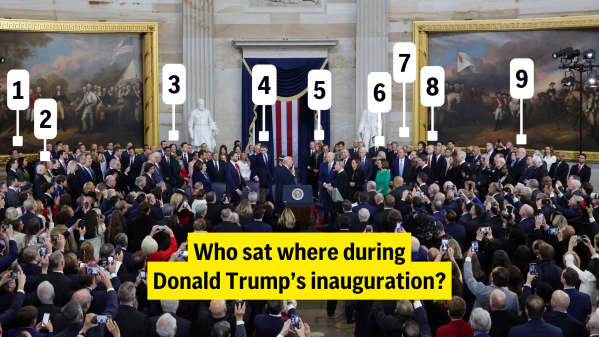
Scattered throughout were the president’s family members and other familiar faces in Trump’s orbit. Lawmakers mostly sat in front of Trump, watching the new president take the oath of office.
Here’s who was up on the dais and who they sat next to.
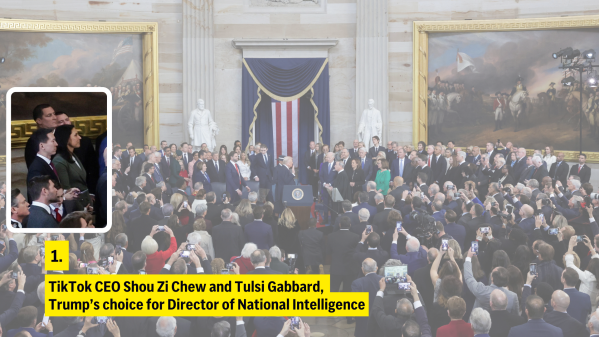
1. Shou Zi Chew, the CEO of TikTok was seated next to Tulsi Gabbard, whom Trump has nominated to be the director of national intelligence. Trump intervened this weekend in an attempt to halt a ban on TikTok, which is seen as a potential national security threat. The president has credited the social network with helping him win last year’s election, but the platform faces a ban if the China-based parent company does not find a Washington-approved buyer.
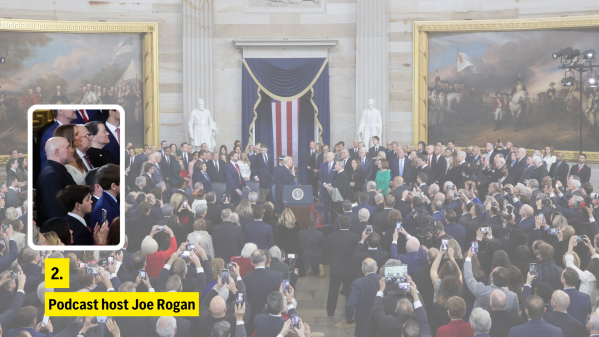
2. Joe Rogan, who is among the world’s most popular podcasters, sat down for a three-hour interview with Trump in the last stretch of the campaign and ultimately endorsed him a day before Election Day. Trump has expressed gratitude to him.
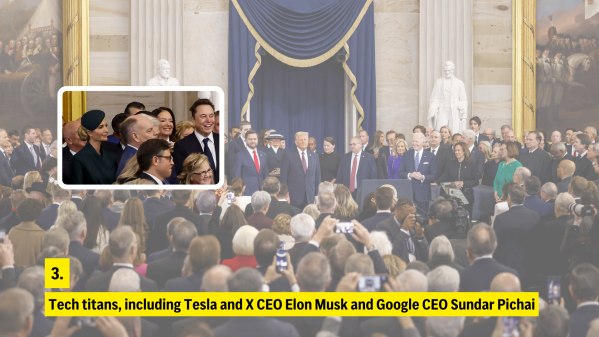
3. A cadre of billionaires and tech titans sat on the same row. They included Facebook founder Mark Zuckerberg, Amazon founder Jeff Bezos, Google CEO Sundar Pichai, and Tesla CEO Elon Musk, the world’s richest man. They were seated behind Trump’s wife, Melania, and children, but ahead of several of his Cabinet nominees. Musk, who has grown closer to Trump since the election, was the one sitting closest to Trump. Bernard Arnault, CEO of French magnate LVMH, the biggest seller of luxury goods in the world whose brands include Louis Vuitton and Christian Dior, was on the opposite side of the dais.
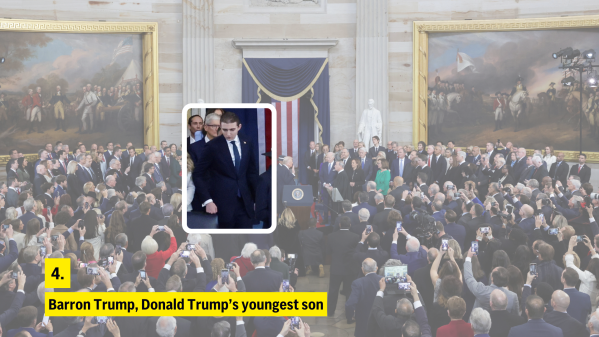
4. Barron Trump is Trump’s youngest son. He has been credited by the president for his campaign’s online outreach, saying he introduced him to internet personalities he had never heard of before. Barron Trump is now 18 and a freshman New York University business student, but he will have a bedroom in the White House.
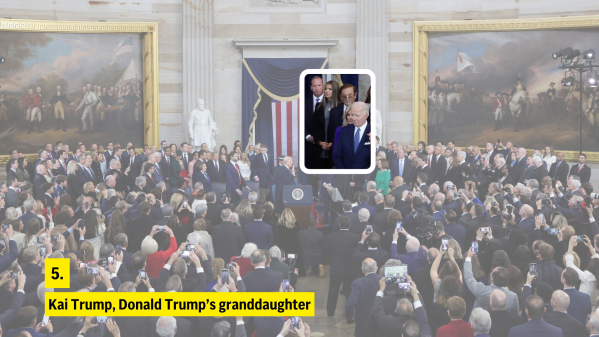
5. Kai Trump, one of Trump’s granddaughters, is a social media influencer and avid golfer. Kai Trump is only 17 but has become more popular over the past year, stepping up on stage at the Republican National Convention and briefly speaking at a rally over the weekend. She is the daughter of Donald Trump Jr., who has helped his father with some of his picks and is seen as an enforcer of loyalty in his orbit.

6. Miriam Adelson and John Paulson were among the largest donors to the Trump campaign and got prime seating for the ceremony next to incoming White House chief of staff Susie Wiles. Paulson, a billionaire investor, was the host of a Palm Beach, Florida, fundraiser that set a single-event record, adding $50.5 million to the campaign last April. Adelson is the co-owner of the NBA’s Dallas Mavericks and the widow of billionaire casino magnate Sheldon Adelson. She is a major supporter of Trump and, with Zuckerberg, was hosting another inaugural event on Monday.
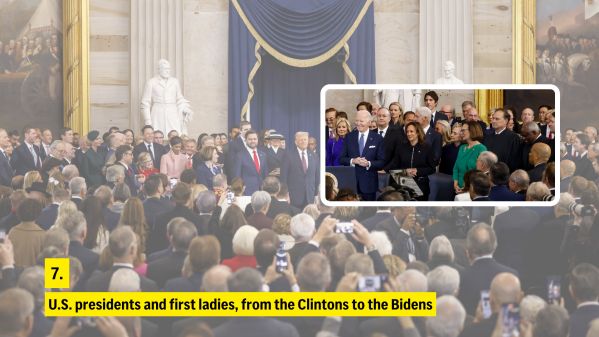
7. Former Presidents Bill Clinton, Barack Obama, and outgoing President Joe Biden were given prime seats as well. All their wives, except for former first lady Michelle Obama, were also seated there. Michelle Obama had previously announced he would be skipping the swearing-in ceremony. She gave no reason.
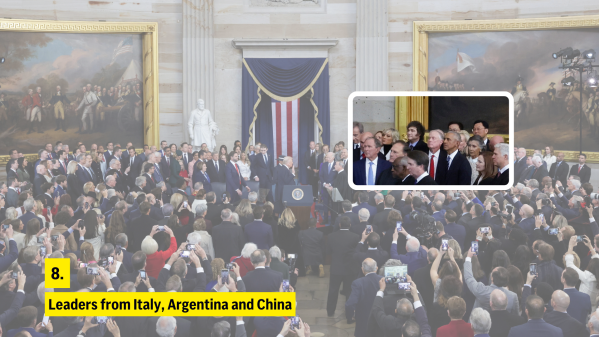
8. In an unprecedented move, Trump invited foreign leaders to the inauguration, and they also got coveted seats for the ceremony. Argentina President Javier Milei was seated next to Italian Premier Giorgia Meloni. They were also next to China’s Vice President Han Zheng, whom President Xi Jinping sent to represent him. The Chinese ambassador to the United States, Xie Feng, was also nearby.
Dignitaries from across Washington and around the world crammed into the U.S. Capitol Rotunda on Monday to watch power transfer peacefully from Democratic former President Joe Biden to his Republican successor, Donald Trump.
It was one of the rare occasions that brought together American leaders past and present in a choreographed display of tradition and bipartisanship.
Photographers from The Associated Press and other news organizations captured moments throughout the day, some historic, others entertaining.
The images are especially notable this year given the ferocious animosity between the teams coming and going.
The photos capture Biden, who framed his presidency as a bridge away from Trump’s first term, partaking in the traditions of the office as he handed power back to the man he’s dubbed a threat to democracy.
They captured Vice President Kamala Harris together with Trump and Vice President JD Vance, the running mates who defeated her in November following a bitter campaign.
They show the billionaires who’ve made their way into Trump’s inner circle, a stark contrast to his first inauguration when most of the nation’s elite shunned the disruptive leader.
They capture some lighthearted moments as well, including former President George W. Bush winking and Trump attempting to kiss his wife, First Lady Melania Trump, but being blocked by the brim of her hat.

.webp)
.webp)
.webp)